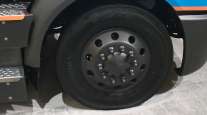Tire Maintenance Effective in Preventing Blowouts
This story appears in the Sept. 3 print edition of Transport Topics.
The price of the service call to replace a blown truck tire on the road can run about $500, industry experts and fleet managers said, adding that the total costs can be much higher.
While road call charges vary depending upon how far away the distressed truck is from the service provider, on average, the call costs $500 to $600, said Peggy Fisher, president of TireStamp Inc., a consulting firm based in Rochester Hills, Mich.
She added, “Now throw in the cost of a new tire at, let’s say $400, and that road service call just went up to $1,205,” if the driver’s lost time is included.
David Foster, vice president of maintenance at Southeastern Freight Lines Inc., backed up Fisher’s claim, saying that the cost to repair or replace a bad tire on the road costs the carrier — which is based in Lexington, S.C. — an average of $1,000. Southeastern Freight ranks No. 27 on the Transport Topics Top 100 list of the largest for-hire carriers in the United States and Canada.
And Walt Weller, vice president of China Manufacturing Alliance, the Monrovia, Calif., supplier of Double Coin tires, said that in 2011, about 16.5 million truck radial tires were sold — costing an average of $400 each.
But that’s just the out-of-pocket expenses, fleet managers said. The true cost may include the loss of business and of a shipper’s confidence in continuing to use that carrier on a regular basis. And, Fisher added, the time a driver spends sitting on the side of the road waiting for road service becomes driving time he loses from his hours-of-service limits.
“The average cost to operate a combination vehicle is about $1.34 per mile for most general freight over-the-road operations,” Fisher said. “When you consider the average speed to be 60 mph, then a 2½- hour tire-related breakdown results in a reduction of 153 miles traveled and a total loss in revenue or cost, depending on how you look at it, of $205.”
In addition, if a truck contract includes penalties for late delivery, the cost could escalate rapidly.
Fisher said she knows of a time-sensitive freight carrier that caters to the automotive industry with just-in-time service that includes such penalties.
“If [the carrier] shuts down a factory line due to late freight delivery, it is penalized $10,000 for each minute the line is down,” she said.
Those costs are why tire maintenance is crucial at many motor carriers, fleet managers said.
Preventing service calls with preventive maintenance is “the best medicine,” said Jim Raynor, vice president of equipment and maintenance for Old Dominion Freight Line, Thomasville, N.C., which ranks No. 14 on the TT Top 100 for-hire list.
“One reason we see so many shredded tires is because many carriers do not have good maintenance programs,” said Mark Stets, director of maintenance, Eastern Area at Con-way Freight. Parent company Con-way Inc., Ann Arbor, Mich., ranks No. 3 on the TT 100 for-hire list.
Like Con-way Freight, large and small carriers try to ensure that tires are well-maintained.
“We actually have a tire specialist working on-site. He does all our buying and monitoring of the tires,” said Mike Stromberg, manager of operations for Skinner Transfer Corp.’s Reedsburg, Wis., facility.
Stromberg said tire maintenance is important for three reasons — safety, better fuel mileage and tire prices.
And speaking of tire prices, Ken McKibben, president of Single Source Solutions, a Reading, Pa., commercial freight consultant company, said that over the past two years, trucking companies have absorbed a 50% to 55% hike in tire costs, as global rubber prices increased. This has made fleet managers keenly aware of the need to ensure tires provide long-term use, he said.
Added Jack Poster, manager of vehicle maintenance reporting standards at American Trucking Associations’ Technology & Maintenance Council: “With the rising price of tires, maintenance is a big concern.”
Poster said the price of tires can be the second-biggest expense for many motor carriers — following drivers’ compensation.
That’s one reason why many fleets have asked Bridgestone America Tire Operations for help in managing their tire programs to reduce downtime.
“They always ask: ‘Help us keep our trucks running,’ ” said Scott Damon, vice president of marketing at Bridgestone Commercial Solutions, Nashville, Tenn.
Tim Miller, customer relations manager for Goodyear Tire & Rubber Co., Akron, Ohio, said that fleets are looking for products, technologies and other ways to help them lower their total cost of operations — and a robust tire-management program can help fleets achieve that objective.
While one type of tire management involves keeping track of the availability of tires a carrier has on hand, for the incidents cited in this story, tire-management programs include checking tires for tread depth, proper inflation, and nails and other debris that could be embedded in the tire. It also includes having a repair service at the ready to handle blowouts on the road.
In fact, because the cost of breakdowns caused by bad tires is so high, many motor carriers have turned their tire maintenance over to outside companies. For example, Old Dominion and Southeastern Freight have contracts with FleetNet America Inc., Cherryville, N.C. And Ryder uses its vendors under its Ryder Customer Response Center to handle tire repairs, replacements and inspections.
Bridgestone offers customized services to large customers through its dealer network, but it also trains its sales people to help smaller fleets, Damon said.
Continental Tire offers several tiers of roadside assistance programs for tires and related services for fleets and owner-operator members of the Owner-Operator Independent Drivers Association. The tire maker said its ContiFleet program focuses on smaller fleets and non-OOIDA owner-operators.
Rick Phillips, director of commercial sales for Yokohama Tire Corp., Fullerton, Calif., said his company has a network of 1,000 locations that can be accessed round the clock through an 800 number.
Goodyear’s Wingfoot Commercial Tire Systems LLC subsidiary offers full tire maintenance services at more than 140 locations throughout the United States.
Michelin said there’s no dispatch fee for its North American fleet account customers or Advantage Program members who buy Michelin tires during the service call.
Experts said one of the most common truck tire problems is underinflation.
“A common rule of thumb is that a constant 20% underinflated condition will reduce the life of a tire by 30% to 40%,” TireStamp’s Fisher said.
She explained that increased flexing because of underinflation causes heat buildup within tire components that fatigues the steel cords and causes them eventually to break. Excessive heat also is generated that eventually destroys the tire, she said.
It is estimated that the average commercial truck or trailer in the United States is operating at about 12% below its optimal inflation pressure, said Alex Chmiel, marketing communications and brand manager for Continental Tire the Americas LLC, Fort Mill, S.C.
Commercial operators need to maintain proper inflation pressures for the load being carried, said Doug Jones, customer engineering support manager at Michelin Americas Truck Tires.
“They need to make sure pre- and post-trip inspections are done and any issues discovered are corrected. It is also important to generate drivers’ awareness of road hazards and the proper measures to avoid them,” Jones said.
Stets said that low tire pressure creates heat which is the leading cause of tire destruction or failure. “When a tire loses air slowly and goes below 80 pounds of PSI [per square inch of pressure], at that point, the tire is flat.”
If a truck is running doubles in the drive and trailer positions and one of those tires goes flat, the best thing to do is wait for assistance, said Alan Haltom, terminal manager at Skinner Transport’s Newcastle, Ind., facility, who added that the damaged tire also can create problems for the freight it is carrying.
In addition, Haltom said that if you continue to drive on a deflated tire it “can overheat and break apart — and you don’t want that to happen.”
If the drive and/or trailer tires are wide-base singles, then there is no other option but to wait for help.
Raynor said Old Dominion’s tires are checked as part of a driver’s pre-trip inspection,
Foster of Southeastern said the company operates “checklanes” at all its shop facilities where units are inspected by a technician before being dispatched. “At those facilities where we do not operate a shop, our drivers inspect all tires as part of their pre-trip inspection,” he said.
Commercial vehicle drivers are required by the Department of Transportation to perform a pre-trip inspection that includes looking at tire conditions, added James Law, Ryder System Inc.’s manager of national tire maintenance.
“At Ryder, we check tires each time a vehicle goes through our service island and every time a vehicle enters our shop, no matter what the reason,” Law said.
Ryder, Miami, ranks No. 10 on the TT Top 100 for-hire list.
A good inspection will not only avoid blowouts, it will detect an embedded nail or other objects, CMA’s Weller said.
“If you have a nail in a tire and the tire is losing air slowly, it gets to a point where the tire cannot support the load and it heats up and basically comes apart,” Weller said.
Continental Tire’s Chmiel said the vast majority of tire-related breakdowns are caused not by sudden air loss such as a blowout but rather by creeping air loss, usually from a puncture such as a nail or a screw.
“Even when there is a blowout, which is only about 3% of cases, these are usually preceded by some type of gradual air loss,” he said.
Such diligence is required no matter the age of a tire, TMC’s Poster said. “A screw or a nail does not know the difference between a new tire or a bald one,” he said.
Another big issue is proper tread depth, said Yokohama’s Phillips.
“Tires that are worn beyond the fleet standard should be removed and replaced immediately,” he said.
Not only should approved tread depth gauges be used to make sure there’s sufficient tread to run on, it’s also important that tires in a dual application — such as the steer or trailer positions — be properly mated with a minimum of 2/32 difference in tread depth, Phillips said.




